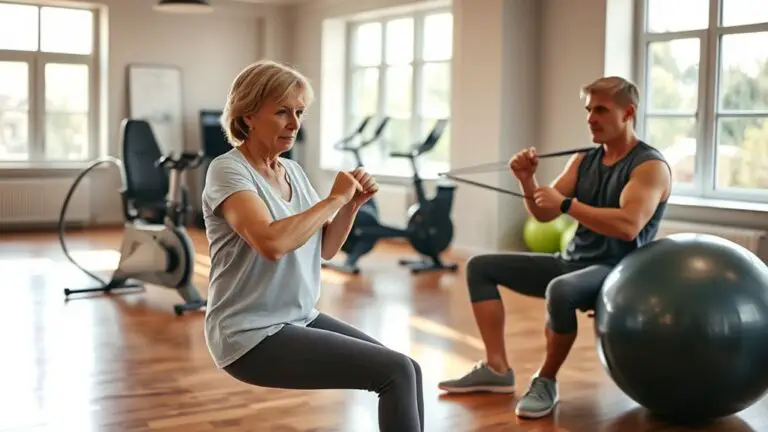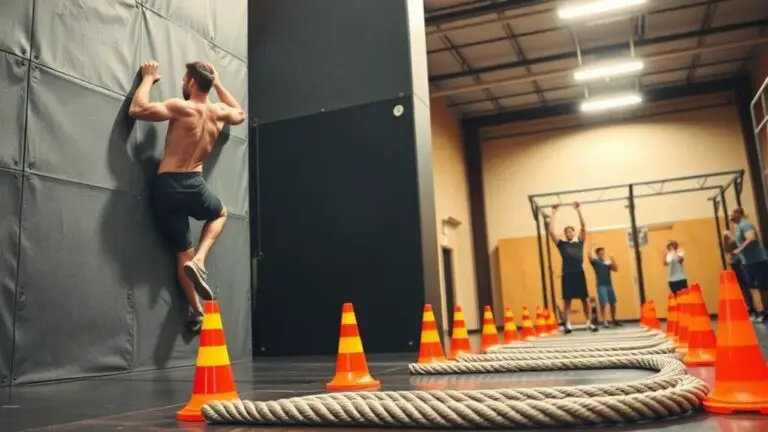Rowing Machine Workouts for Maximum Calorie Burn
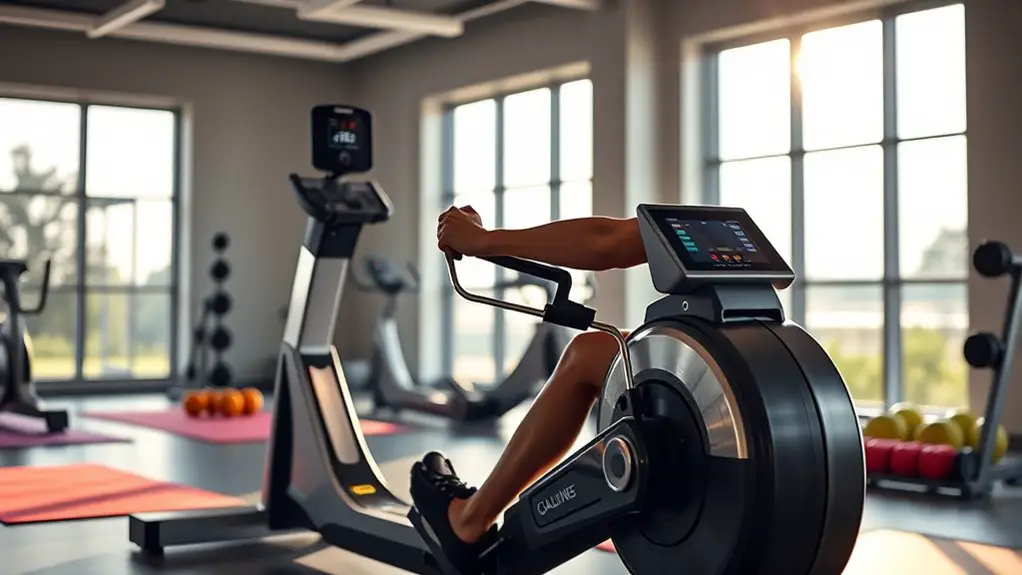
Rowing machine workouts are one of the most efficient ways to burn calories, with the potential to torches up to 600 calories per hour. They engage multiple muscle groups, providing a full-body workout that’s low-impact and easy on your joints. To maximize calorie burn, try incorporating high-intensity intervals into your sessions or alternate between steady rowing and bodyweight exercises. If you want to discover more tips on optimizing your workouts, keep exploring the details ahead.
Understanding the Benefits of Rowing Machine Workouts

Have you ever wondered why rowing machine workouts are gaining popularity in fitness routines? One reason is their effectiveness in calorie burning. Rowing engages multiple muscle groups, including your legs, core, and arms, making it a full-body workout. This means you’re not just focusing on one area; you’re enhancing overall fitness while torching calories.
Plus, rowing is low-impact, which means it’s easier on your joints compared to other high-intensity workouts. This makes it an excellent choice for those wanting a safe yet challenging routine without risking injury. You can control the intensity, tailoring your workout to your fitness level.
This adaptability, combined with the benefits of muscle engagement, guarantees you get a balanced workout that promotes strength and endurance. So, if you’re looking to boost your fitness safely while maximizing calorie burn, rowing machines might just be the perfect addition to your routine.
Setting Up Your Rowing Machine for Optimal Performance
To get the most out of your rowing machine workouts, setting up your machine correctly is key. Start by making the necessary machine adjustments to guarantee you’re comfortable and secure. Adjust the foot straps so they’re snug but not too tight; your feet should feel stable without restriction. The seat height should allow your knees to be slightly bent at the top of your stroke for peak power and safety.
Next, check the damper setting to match your fitness level; a lower setting mimics water rowing, while a higher setting increases resistance. Don’t forget to monitor your performance metrics, such as stroke rate and calories burned, to track your progress and maintain motivation.
Finally, verify there’s enough space around your machine to avoid any accidents during your workout. With these adjustments, you’ll set yourself up for successful and safe rowing sessions.
Beginner Rowing Workout: Getting Started
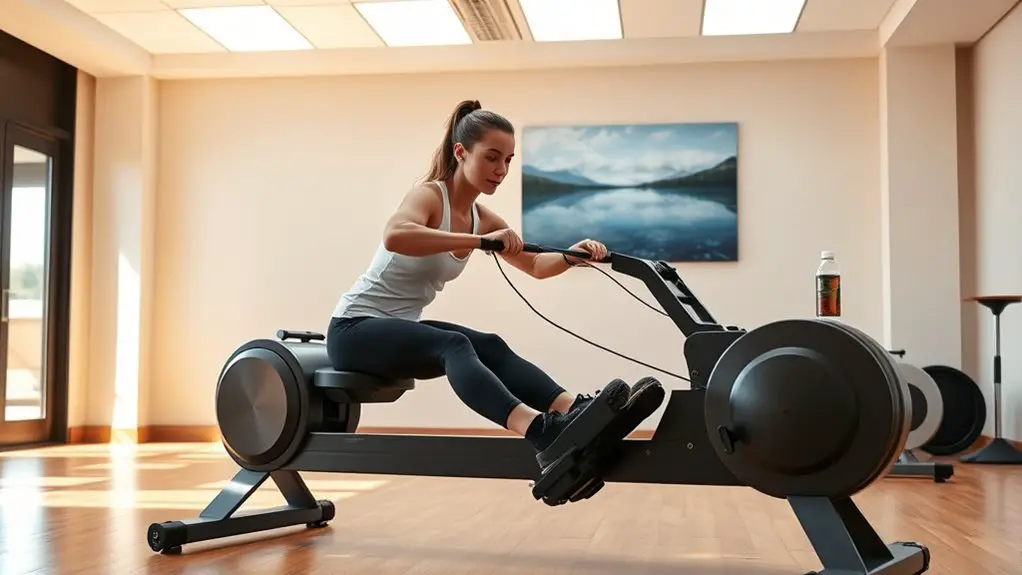
When you’re starting out with rowing, it’s essential to nail down the proper technique to avoid injury and maximize your workout. Understanding the basic structure of your rowing sessions will also help you build endurance and strength. Let’s break down how to get you on the right path with your beginner rowing workouts.
Proper Rowing Technique
Although it may seem straightforward, mastering proper rowing technique is essential for maximizing your workout and preventing injury. Start with ergonomic positioning; sit tall with your back straight and shoulders relaxed. Your feet should be securely strapped in, and your knees should align with your feet. As you begin your stroke, hinge at the hips and engage your core for stability. Focus on smooth, controlled movements, emphasizing stroke efficiency rather than speed. Pull the handle towards your chest while keeping your elbows close to your body, then extend your arms and lean forward to return to the starting position. Remember, proper form not only enhances your performance but also helps reduce the risk of strain or injury.
Basic Workout Structure
A basic rowing workout typically consists of three main components: warm-up, workout intervals, and cool-down. Start with a 5-10 minute warm-up at a low intensity to prepare your muscles and joints, reducing the risk of injury. Next, focus on your workout intervals. For beginners, aim for shorter intervals at moderate intensity levels—perhaps 20-30 seconds of hard rowing followed by a minute of easy rowing. This helps build endurance safely. It’s important to monitor your workout frequency; aim for 2-3 sessions a week, allowing your body to recover between workouts. Finally, finish with a 5-10 minute cool-down, gradually decreasing your intensity. This helps to lower your heart rate and promotes recovery, ensuring you stay safe and effective in your training.
Intermediate Rowing Workout: Building Endurance
Building endurance on a rowing machine requires a focused approach that balances intensity with recovery. For your intermediate workout, aim for 20 to 30 minutes of steady-state rowing at a moderate pace. Start with a five-minute warm-up to prepare your muscles and prevent injury. During your workout, maintain a consistent stroke rate while focusing on your technique. This helps with stamina building and guarantees you’re getting the most out of your endurance training.
Incorporate short intervals of increased intensity for one minute every five minutes. This will challenge your body without overwhelming it. Remember to listen to your body; if you feel fatigued, slow down or take a brief pause. After your workout, cool down with five minutes of easy rowing, followed by stretching to aid recovery. Consistency is key, so aim to include this workout two to three times a week for best results.
Advanced Rowing Workout: High-Intensity Intervals
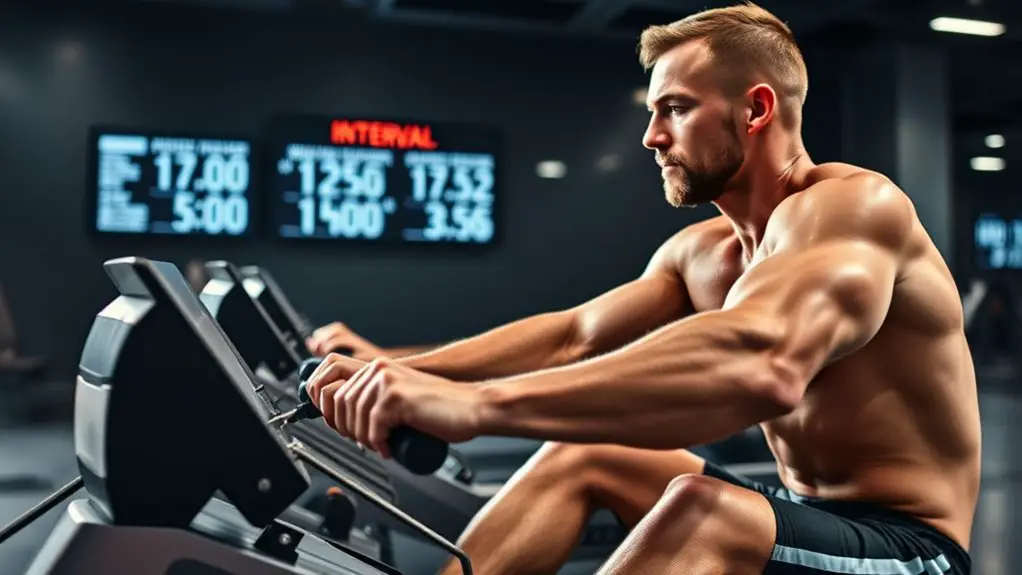
When you’re ready to ramp up your rowing game, high-intensity intervals are the way to go. Understanding the right interval structure, mastering your technique, and ensuring proper recovery are essential for maximizing your performance. Let’s break down each of these elements to help you get the most out of your advanced workouts.
Interval Structure Explained
High-intensity interval training (HIIT) on a rowing machine can take your fitness to the next level, as it combines bursts of maximum effort with periods of active recovery. To effectively structure your intervals, aim for a balance between interval duration and intensity levels. For example, you might row at a high intensity for 20-30 seconds, followed by 1-2 minutes of lower intensity to recover. This method allows your body to adapt and improve while minimizing the risk of injury. Always listen to your body; if you feel fatigued, extend your recovery periods. By carefully managing your interval duration and intensity levels, you’ll maximize calorie burn while staying safe and maintaining proper form throughout your workout.
Proper Rowing Technique
Mastering proper rowing technique is essential for maximizing your performance during high-intensity interval workouts. Start with a proper grip on the handle, keeping your wrists straight to avoid strain. Maintain good body alignment by engaging your core and keeping your back straight throughout the stroke. As you pull, focus on your stroke rhythm; drive with your legs first, then lean back slightly and pull the handle towards your chest. Don’t forget your breathing technique—exhale as you push away and inhale as you return. This guarantees your muscles get adequate oxygen, enhancing endurance and safety. By practicing these elements, you’ll not only boost your calorie burn but also reduce the risk of injury during intense sessions.
Recovery Between Intervals
While pushing your limits during high-intensity rowing intervals, the recovery period between each set is just as vital for peak performance. Take this time to cool down and allow your heart rate to return to a safer level. Focus on deep, controlled breathing to aid recovery. Incorporating effective hydration strategies is essential; drink water or an electrolyte-rich beverage to replenish lost fluids. Aim for a brief rest of 1 to 2 minutes, depending on your fitness level, to guarantee your muscles are ready for the next round. Remember, adequate recovery not only enhances your performance but also reduces the risk of injury. Listen to your body and adjust your rest periods as needed to stay safe while maximizing your workout.
Full-Body Rowing Circuit: Combining Strength and Cardio
If you’re looking to elevate your fitness routine, a full-body rowing circuit is a fantastic way to blend strength training with cardio. This workout not only promotes full body engagement but also enhances your cardio strength, making each session efficient and effective. Start by warming up for a few minutes on the rowing machine to prepare your muscles and joints, ensuring safety throughout.
Once you’re ready, alternate between rowing and bodyweight exercises like squats and push-ups. Row for one minute, then switch to 30 seconds of squats, followed by another minute of rowing. Repeat this sequence for 20 to 30 minutes, adjusting the intensity based on your fitness level.
Always listen to your body; if you feel fatigued, take a short break. This circuit not only builds strength but also boosts your cardiovascular endurance, giving you a well-rounded workout experience.
Rowing Machine Workout for Weight Loss
Rowing machine workouts can be a powerful tool for weight loss, particularly because they engage multiple muscle groups while providing an effective cardiovascular challenge. To maximize your results, set specific calorie targets for each session. Aim to burn between 300 to 500 calories, depending on your fitness level and goals.
Incorporating varying workout frequencies, such as three to five sessions per week, can help you stay consistent and keep your metabolism revved up. Consider alternating between steady-state rowing and interval training to enhance calorie burn and keep things interesting.
Always listen to your body and take rest days as needed to prevent overtraining. Remember, safety comes first, so ascertain your rowing technique is proper before increasing intensity. By staying committed and mindful of your calorie targets and workout frequencies, you’ll be on your way to achieving your weight loss goals effectively and safely.
Tips for Maintaining Proper Form While Rowing
To get the most out of your rowing workouts, maintaining proper form is essential for both efficiency and injury prevention. Focus on ergonomic adjustments to fit your body and avoid common mistakes that can lead to strain.
Here’s a quick reference table to help you stay on track:
| Key Aspect | Tips |
|---|---|
| Back Position | Keep your back straight, not rounded. |
| Grip | Use a loose grip; avoid over-tightening. |
| Leg Drive | Push through your heels, not your toes. |
| Finish Position | Keep your elbows close and wrists straight. |
Tracking Your Progress and Setting Goals
While you’re honing your rowing technique, tracking your progress and setting achievable goals can greatly enhance your workout experience. Effective goal tracking helps you stay motivated and focused. Consider these progress measurement strategies:
- Keep a workout journal to record your rowing times and distances.
- Set short-term goals, like rowing for an extra five minutes each session.
- Use a fitness app to monitor your calories burned and strokes.
- Celebrate milestones, like reaching a new personal best.
Frequently Asked Questions
How Often Should I Use a Rowing Machine for Best Results?
To achieve the best results, you should aim for a balanced approach. Frequency guidelines suggest using the rowing machine about three to five times a week, depending on your fitness level. It’s important to vary your workout intensity; incorporate both moderate and high-intensity sessions. Always listen to your body and allow for rest days to prevent injuries. Consistency, combined with proper technique and recovery, will help you reach your fitness goals safely.
Can Rowing Machines Help With Muscle Toning?
Did you know that incorporating strength training can increase your metabolism by up to 15%? When you use a rowing machine, you’re not just burning calories; you’re also enhancing muscle definition and toning your entire body. It engages multiple muscle groups safely, making it an effective option for muscle toning. Just be sure to maintain proper form and start slow to prevent injury. You’ll see results while staying safe and strong!
Are There Any Age Restrictions for Using a Rowing Machine?
There aren’t strict age restrictions for using a rowing machine, but there’re some age recommendations to take into account. Generally, adults and older teens can safely use them, provided they follow safety guidelines. It’s important to guarantee proper form and start with a comfortable resistance level to prevent injury. If you’re younger or have concerns, it’s best to consult a physician or fitness professional before getting started. Staying safe is key to enjoying your workout!
What Should I Wear When Using a Rowing Machine?
When you’re using a rowing machine, it’s important to wear appropriate attire. Opt for comfortable, moisture-wicking clothing that allows for easy movement. Avoid loose garments that could get caught in the machinery. As for footwear options, choose supportive athletic shoes with a good grip. This’ll help keep your feet secure on the footrests, enhancing your safety during the workout. Staying comfortable and secure guarantees you can focus on your rowing technique.
How Do I Maintain My Rowing Machine?
To keep your rowing machine in top shape, think of it like a car; regular maintenance is key. Set a cleaning schedule to wipe down the seat and handle after each use, preventing sweat buildup. Every few weeks, check the resistance mechanism and lubricate it if necessary. Finally, inspect the cables for wear. By following these maintenance tips, you’ll guarantee a safe and smooth experience each time you row.
